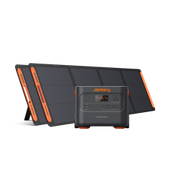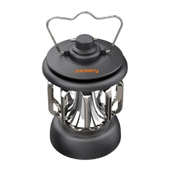If you plan to use a power tool for a DIY task at your home, you need to ensure the electrical system can handle the amps and wattage of the tools being used. On average, small power tools such as jigsaws and sanders draw 2 - 8 amps. However, larger power tools like table saws and circular saws typically consume 6 - 16 amps of current. You can calculate how many amps a typical power tool uses by checking the appliance's nameplate.
Some tools like air compressors and duct collectors might need more power. Jackery Solar Generators are available in various sizes and can charge a wide range of power tools such as electric drills, jig saws, miter saws, etc. They are portable by nature, so you can move the solar battery backup anywhere and power appliances. The foldable handles, ergonomic design, and large capacity of the solar battery charger make them ideal for various scenarios.
Key Takeaways
- The typical amp usage of small power tools is 2 - 8 amps, whereas the large power tools draw 6 - 16 amps of current.
- You can calculate the amps of power tools by dividing the wattage by volts.
- The value of amps will depend on the type, size, and capacity of power tools.
- Investing in solar generators can help you charge power tools outdoors and even during unexpected outages.

How Many Amps Does a Power Tool Use
Power tools generally operate on a spectrum of amps requirements based on their functionalities and power capabilities. The power tool amps indicate the total current it needs under a full load. Small power tools draw 2 - 8 amps, while larger ones need 6 - 16 amps. Heavier machinery might demand 20 amps or more of current.
Definition of Amps, Volts, Watts, and Running Watts
Electrical units such as amps, volts, and watts measure different aspects of electricity. They will help you determine the power usage of the power tools and choose the charging method. Let's explain each term briefly:
Amps: The amperage determines the speed or the rate at which the electrons flow through the conductor. The typical amp usage of the power tools is 2 - 20A.
Amps = Watts ÷ Volts
Watts: Wattage is the power or rate at which electrical energy is transferred in a circuit. Different power tools consume different amounts of electricity per hour. For example, the type and size of the appliance determine how many watts a circular saw uses.
Watts = Volts × Amps
Volts: Voltage measures the difference in electrical potential or number of electrons flowing between any two points in an electrical circuit. In the United States, most power tools operate at 120V, while some might need 240V.
Volts = Watts ÷ Amps
Running Watts: Running or rated wattage is the amount of power consumed by power tools when they operate continuously. It is typically 2-3 times lower than the starting wattage.
Running Watts = Running Amps × Volts
How Many Amps Do Different Types of Power Tools Use
Power tools have a wide range of amp ratings depending on their type and size. You can expect small portable power tools to draw 2 - 8 amps. Large ones consume 6 - 16 amps. A compact impact driver might draw 2.6 amps to a maximum of 20.5 amps. The compact blower consumes 5 - 17 amps, while corded power tools are often rated for 8 amps at 120V. Here's a table indicating the different types of power with their amps and appliance wattage chart:
Power Tool Types | Power Tool Wattage | Actual Energy Usage (Almost ½ of rated wattage) | Amps (= Watts / Volts) |
Power Drill | 720W | 360W | 6 amps |
Edger | 960W | 480W | 8 amps |
Electric Chainsaw | 1200W | 600W | 10 amps |
Electric Lawn Mower | 1440W | 720W | 12 amps |
Electric Pressure Washer | 1200W | 600W | 10 amps |
Electric String Trimmer | 600W | 300W | 5 amps |
Circular Saw | 1400W | 700W | 11.6 amps |
Chop Saw | 1500W | 750W | 12.5 amps |
Table Saw | 1800W | 900W | 15 amps |
Miter Saw | 840W | 420W | 7 amps |
Orbital Sander | 600W | 300W | 5 amps |
Paint Sprayer | 360W | 180W | 3 amps |
Router | 600W | 300W | 5 amps |
Water Pump | 1000W | 500W | 8.3 amps |
Wet/Dry Vacuum | 888W | 444W | 7.4 amps |
Winch | 1800W | 900W | 15 amps |
Jigsaw | 300W | 150W | 2.5 amps |
Electric Weed Trimmer | 500W | 250W | 4.1 amps |
Belt Sander | 1000W | 500W | 8.3 amps |
Disc Sander | 1200W | 600W | 10 amps |
Worm Drive Saw | 1560W | 780W | 13 amps |
Disc Grinder | 2000W | 1000W | 16.6 amps |
Air Compressor (Average) | 2000W | 1000W | 16.6 amps |
How Many Amps Does a Power Tool Draw on Startup
The startup amps of a power tool are typically 2 - 3 times higher than the running amps because of the inrush current or a surge of electricity needed to overcome initial resistance. Since most power tools feature built-in motors, they need more amps and watts when the appliance starts up. Let's explain the concept briefly:
Starting Watts vs Running Watts
The starting and running wattage of power tools refers to the amount of electricity required during the appliance's startup and normal operation. The running watt is the continuous power consumed by the appliance when it operates at a normal speed.
The startup watts refer to the higher amount of power the appliance needs when it is turned on. It is generally 2-3 times higher than the running wattage and lasts only a few seconds. Suppose you have a power tool drawing a rated wattage of 1000W of electricity per hour. In this case, the startup wattage will be 2000-3000W.
You can calculate the startup wattage using the below formula:
Starting Watts = Running Watts × 2 = 1000W × 2 = 2000W
Startup Amps vs Running Amps
Just like wattage, power tools draw higher startup amps when they start up than when they are operating normally. Small and large power tools require 2-3 times higher startup amps than the running amps, which last only for a few seconds. On the other hand, the rated amps are the steady current that the power tools draw when running at a normal speed.
Let's say the rated amps of a power tool is 5 amps and operates at 120V. The relationship between rated and startup amps is as follows:
Startup Amps = Running Amps × 2 = 5A × 2 = 10 amps
How to Calculate Your Power Tool Amps
Power tools use a lot of electricity, so it is essential to make sure you have an adequate power supply for charging them. Thankfully, there are multiple methods to calculate the amps of power tool that you can try:
Method 1: Manufacturer Details — Energy Star Rating
One simple way to check the power tool amps is by referring to the nameplate located on the motor housing or the tool's body. The user manual and the appliance itself include information about the amps and volts, so you don’t have to perform any calculations.
Small power tools typically use 2–8 amps, while larger ones use 6–16 amps. Duct collectors and air compressors may need even more power. Energy Star products also indicate the appliance's energy efficiency. The more stars there are, the more energy efficient they are than other products in the market.
Method 2: Determine the Amps From the Wattage
Ohm's Law indicates the relation between the appliance's amps and watts. If you know the power tool's wattage, you can use the simple formula to determine its amps.
Amps = Watts ÷ Volts
For example, if a power tool consumes 1000W of electricity per hour and operates at 120V, the values of amps will be equal to:
Amps = 1000W ÷ 120V = 8.3 amps
When you use a 1000-watt power tool for one hour daily, your total watt-hour consumption will be 1000Wh per day.
Daily Amps = Daily Watt-Hours ÷ Volts = 1000Wh ÷ 120V = 8.3 amps per day
Method 3: Use a Power Meter
If you want to calculate the amps of a power tool straightforwardly yet accurately, consider buying a power meter. It typically measures the appliance's real-time electrical parameters, such as amps, watts, and volts.
All you need to do is plug the power meter into a power outlet and then plug the power tool into the power meter. Next, you can switch on the power tool and let it run at full speed. The power meter will display the electrical ratings, including amps, watts, and volts.
Tips to Save Your Electricity Bill
Power tools are counted among the power-hungry appliances and can impact your electricity bills to a large extent. If you want to save your electricity bills because of the power tools, here are a few ways to check out:
Unplug Electronics When Not in Use: Many electronics, such as power tools, continue to draw power even when they are turned off but plugged in. For this reason, you should turn off and unplug the electronics when you are not using power tools.
Use Tools During Off-Peak Hours: Electricity prices differ between on-peak and off-peak hours. If you want to reduce your electricity bills, you should consider using power tools during off-peak hours when the prices are lower.
Choose Energy Star Appliances: When buying power tools, look for the Energy Star label. Energy-star appliances meet strict energy regulations and consume less electricity than similar appliances.
Consider Solar Energy: Investing in a solar generator can help you reduce or even eliminate reliance on the electricity grid. Jackery Solar Generators are portable and efficient charging solutions that can power up to 99% of appliances for hours. The large-capacity generators have wheels and handles to move them outdoors for charging appliances.
Solar Generators for Power Tools
Jackery Solar Generators are reliable and eco-friendly generators designed to charge a wide range of off-grid tools, such as electric drills, jigsaws, chainsaws, etc. They combine portable power stations and foldable solar panels to collect the sun's energy, convert solar into DC electricity, and charge appliances using AC electricity.
Jackery can power circular saws, and the solar generator is easy to set up. All you need to do is unfold and place the solar panels under direct sunlight. Then, the solar cable connects the portable power station with the solar panels. The foldable panels absorb solar energy and convert it into DC electricity. Then, the pure sine wave inverter of the portable power station converts DC to AC electricity to charge the power tools and other appliances.
Jackery Solar Generator 1000 Plus
The Jackery Solar Generator 1000 Plus is a compact and portable solar-powered generator that charges 99% of household or outdoor appliances. It can power electric drills, chainsaws, table saws, etc., in remote locations where the electrical outlets are unavailable. The sturdy handle ensures easy carrying and movement to different places to charge the appliances anywhere. It's also expandable by nature, and the battery capacity can be extended up to 5kWh with the Jackery Battery Pack 1000 Plus.










- More Power in Smaller Size: With a capacity of 1264Wh and a 2000W output, the 1000 Plus supports 99% of devices.
- Expandable Capacity: Supports up to 3 add-on battery packs, expanding up to 5kWh and ensuring 1-3 days of home backup power
- Industry-leading Sustainability: Setting new standards for sustainability. It is the first in the industry to be verified by TÜV SÜD.
- Long-lasting Reliability: LiFePO4 battery cells, lasting up to 10 years - providing 4,000 charge cycles.
- Intelligent Control: With the advanced APP feature, via WiFi or Bluetooth.
- Explorer 1000 Plus: 3-year warranty + 2-year extended warranty. Solar Saga 100W: 2-year warranty + 1-year extended warranty (automatically applied when purchased from our official website)
- Power on the move! With our newest arrival, the 100 Prime Solar Panel, our Solar Generator 1000 Plus Roam Kit can keep you powered while you're driving! The 100 Prime is a DIY solar panel that can be mounted directly onto the top of your vehicles with ease! Learn More>
Jackery Solar Generator 2000 Plus
Suppose you are looking for a solar generator that can act as a reliable home battery backup during power outages or off-grid living power solutions. In that case, you can go ahead with the versatile Jackery Solar Generator 2000 Plus. It can charge different sizes and types of power tools, such as table saws, electric drills, etc., operating at 120V. Despite the large capacity, the solar generator features double wheels and a foldable handle for easy movement.










-
Get up to $1,589.7 in rebates. Click for information
- Expandable for Versatile Scenarios: 2-24 kWh of expandable capacity
- Leaping Performance: Powers Heavy-duty Devices up to 6000W
- Ultra Fast Solar Charging: Advanced IBC Technology, Fast Solar Charge in 2 Hours with Solar Panel 200W*6
- Long-lasting Reliability: Outstanding LiFePO4 Battery with 10-Year Lifespan
- ChargeShield Technology: Using a unique variable-speed charging algorithm, fast charge technology boosts battery life by 50%
- High Power Output: Maximum 6,000 W power in parallel connection and 120/240V expandable voltage
- Explorer 2000 Plus: 3-year warranty + 2-year extended warranty. Solar Saga 200W: 3-year warranty + 2-year extended warranty (automatically applied when purchased from our official website)
-
Use a transfer switch (Value $399.99) to create a whole-home backup solution. Power from any outlet, anywhere in the house, click here to learn more!
Jackery Solar Generator 3000 Pro
The Jackery Solar Generator 3000 Pro is a large-capacity generator that can charge 99% of your power tools and other appliances. It also features double wheels and foldable handles to move the generator outdoors and charge power tools. When you are not charging the power tools, the battery backup for the home can charge other essential appliances such as refrigerators, water heaters, ACs, etc.









- Get up to $839.7 in Rebates. Click for information
-
Large Capacity: 3024Wh that can power up to 99% of outdoor appliances
- Ultra Fast Charging: Fully solar charged in 3-4 hours and wall charged in 2.4 hours
- Portable Design: Pull rod and double wheels
- Easily Accessible: Smart App Control
- Cold Friendly: Functional in temperatures down to -20°C / -4°F
- Silent: Unique quiet canyon cooling system
- All-around Safety: Fully upgraded BMS
-
Explorer 3000 Pro: 3-year warranty + 2-year extended warranty. Solar Saga 200W: 2-year warranty + 1-year extended warranty (automatically applied when purchased from our official website)
-
Use a transfer switch (Value $399.99) to create a whole-home backup solution. Power from any outlet, anywhere in the house, click here to learn more!
Jackery Products | Capacity & Output Watts | Power Tool Running Time |
Jackery Solar Generator 1000 Plus | Capacity: 1264Wh Rated Output: 2000W | Miter Saw (840W) = 1.2H Orbital Sander (600W) = 1.7H Jigsaw (300W) = 3.5H Electric Weed Trimmer (500W) = 2.1H Drill (720W) = 1.5H Edger (960W) = 1.1H |
Jackery Solar Generator 2000 Plus | Capacity: 2042.8Wh Rated Output: 3000W | Circular Saw (1400W) = 1.2H Table Saw (1800W) = 57 minutes Electric Chainsaw (1200W) = 1.4H Electric Lawn Mower (1440W) = 1.2H Pressure Washer (1200W) = 1.4H Electric String Trimmer (600W) = 2.8H |
Jackery Solar Generator 3000 Pro | Capacity: 3024Wh Rated Output: 3000W | Circular Saw (1400W) = 1.8H Table Saw (1800W) = 1.4H Electric Chainsaw (1200W) = 2.1H Electric Lawn Mower (1440W) = 1.7H Pressure Washer (1200W) = 2.1H Electric String Trimmer (600W) = 4.2H |
FAQs About Power Tools
What power tools require 20 amps?
Drills, miter saws, table saws, hammer drills, dust collectors, and air compressors are some power tools that need 20 amps.
How much electricity does a power tool use?
The amount of electricity a power tool uses depends on the type of tool and how it's being used. For example, an angle grinder uses 500-2000W, a band saw uses 800-1500W, and a chainsaw/circular saw uses 1200-2400W.
Conclusion
Power tools are considered the most power-hungry appliances. The moment they are turned on, they consume their fair share of electricity and current. However, how many amps a typical power tool uses will depend on its type and size. Jackery Solar Generators are large-capacity solar battery chargers that can charge high-power appliances such as angle grinders, table saws, chain saws, etc. They are portable and compact enough to carry around for indoor or outdoor DIY projects.























































































































Leave a comment